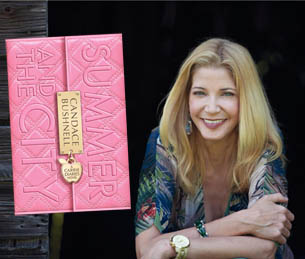Sex and the City die-hards of the world, rejoice, because Candace Bushnell has finally connected the dots between our favourite Manhattan gal’s childhood and her well-documented life in the big city. Whether you loved reading about Ms. Bradshaw’s small-town teenage life in The Carrie Diaries or you thought that one was better left for the tweens, I strongly advise you to get your hands on a copy of the highly anticipated follow-up, Summer and the City, released today. In this entertaining compilation of friendship hurdles, man problems and hysterical tales that are so typically Carrie, we not only learn about her transition into big-city living and finding her way as a writer, but we also discover what we’ve all been dying to know—how she came to meet her future best girlfriends.
I had the chance to ask the author some of my most burning questions about her career, the ever-relatable Carrie Bradshaw and the Sex and the City saga. Here’s what she had to say.
I know the Sex and the City book was inspired by the column you wrote for the New York Observer—to what extent, if any, is Carrie’s story/character based on yourself?
The column, Sex and the City, was sold as a book after I’d written four or five columns. So the column became, in essence, the serialization of a book. The character of “Carrie Bradshaw” was my alter ego, which I created because I didn’t want to write the entire column/book in first person.
When did you decide you were going to write The Carrie Diaries and Summer and the City? How did the idea come about?
I probably began talking about writing the prequels in 2006 or 2007. I have contracts for two to four novels at any given time, so I have to write them in a particular sequence. I had to finish and publish One Fifth Avenue and go on a three-month book tour before I could begin The Carrie Diaries.
When you wrote Sex and the City, how much of Carrie’s pre-NYC life had you thought about?
I didn’t need to think about it—I’d lived it! To me, Sex and the City is the culmination of fifteen years of my life in New York City. It’s about a type of woman in a very specific period of time, beginning in the late seventies/early eighties. So it was pretty natural to go back and mine that period.
Do you have any plans to continue the Sex and the City story somehow?
Haven’t decided yet. But I could sit down tomorrow and come up with twenty story lines for the characters in the ‘80s if I felt like it.
Did you have any idea when you wrote Sex and the City that it would turn into such an international phenomenon? How do you feel about giving way to a set of characters that inspired and entertained women everywhere?
No one had any clue as to what would happen! When we made the pilot in 1997, we didn’t know for months if it would be picked up for a series. After the first series, we weren’t sure there would be a second. There was no grand scheme—it simply evolved. As for entertaining and inspiring women—I think I’d always wanted to do that as a kid.
Why do you think so many women relate to Carrie’s character?
I used to say she was an “every girl,” but in writing the books, I’ve realized she has to be a real original from the beginning to “turn into” Carrie Bradshaw.
And what did you think of Sarah Jessica Parker playing Carrie?
Fantastic.
How would you describe your personal style and fashion taste?
Ha! I dress up when I have to. When I don’t, I like to wear crazy plaid pants and porkpie hats.
What advice would you give to young writers today who are just starting out?
I spent so much of my late teens and early twenties trying to figure out how to be a writer—although I was already published at nineteen. Spend less time thinking about it and more time doing it. And don’t write the review in your head before you’ve written the story.
What’s next for you?
I’m working on a novel entitled, The Two Mrs. Stones.
~ Lindsay MacAdam



 Follow Us On Instagram
Follow Us On Instagram



 We’ve gathered
We’ve gathered 
 We’re giving aw
We’re giving aw